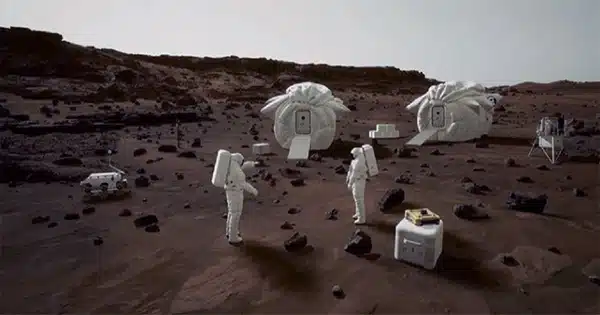ON JUNE 25, four crew members will gear up and head to Mars, where they will spend a year in a small 3D-printed house with just each other for company. But these space adventurers aren’t going anywhere. Their simulated Martian environment is housed in a big hangar at NASA’s Johnson Space Center in Houston, and it’s intended to test the psychological and sociological obstacles that early travelers to the Red Planet will face, where remoteness and severe terrain will make living difficult.
Chapea, which means Crew Health and Performance Exploration Analog, is the name of the program. When future astronauts actually land on the ruddy Martian soil, NASA hopes that lessons learned from this innovative social experiment will help them, such as understanding how the space agency can make the crew comfortable and help them get along with one another, or deal with loneliness or homesickness. “For me, it would be a big accomplishment if, at the end of the year, the crew is complete and there hasn’t been any attrition. Although it sounds conceivable, Kelly Haston, the mission’s biomedical researcher, and commander, thinks it will be exceedingly difficult. “We are aware that we have a way out. There is an escape sign since we are volunteers. You won’t find that on Mars.”
Haston and her crewmates—Ross Brockwell, Nathan Jones, and Alyssa Shannon—will dwell in a tight space without touch with other people, just like the first wave of Martian explorers. They’ll be able to speak with mission control, but only after a 20-minute delay, as if they were 100 million miles away. They’ll see nothing but a barren, lifeless world, which NASA is replicating with an enclosed area covered in Martian mural pictures and a 1,200-square-foot sandbox filled with red sand. They will have several opportunities each week to go outside for “Mars walks” while wearing spacesuits.

To mimic NASA’s plans for the next trips, the 1,700 square-foot building they’ll dwell in was 3D printed using a mimicked Martian regolith. It resembles a high-end dormitory for space workers because of its Ikea-like furnishings, spotless interiors, and bright lighting. The habitat has a modest work area, a kitchen, two restrooms, an exercise room, and small individual crew quarters. There is also a social area with a table for team meals and meetings, seats, and a couch. That’s pretty much it. According to deputy project manager Raina MacLeod, “the Chapea mission’s objective is to collect data on the crew’s health and performance while they are living in a realistically constrained environment and leading a lifestyle that could be expected of Mars astronauts.”
While the idea of confining four individuals in a single structure for an extended period of time and watching how they fare sounds like a reality TV show, the crew will be disciplined and given duties to do. In many aspects, their daily lives will be comparable to those of astronauts aboard the International Space Station, albeit with greater space and no floating. (People will feel lighter and bouncy on Mars because it is smaller and less massive than Earth, but this is difficult to portray.) During their working hours, the crew will carry out mission operations such as “Mars walks,” growing plants, obtaining exercise, cleaning the habitat, and maintaining equipment.
They will have to rely on reconstituted dehydrated food in between small amounts of fresh food brought by rare cargo resupply trips because the kitchen only has a small oven and fridge. Although having a shower, toilet, and sink with running water in their bathrooms is a significant improvement over living in microgravity, the water for each crew member will be rationed due to the scarcity of water on Mars.
NASA will monitor the Chapea crew using cameras installed within the habitat, and someone will be available to them at mission control 24 hours a day, seven days a week. The crew, like astronauts in Earth orbit, will have private meetings with medical professionals to monitor their mental and physical health, and those will be the only communications that are not subject to the typical time delay. They will also be asked to complete surveys about their mood and temperament. The crew will be able to communicate with friends and family, but while they will be able to send and receive video messages and emails, they will be unable to have real-time chats with them.
Although the accommodations appear pleasant, the crew members’ relative seclusion may have an impact over time, so it’s crucial to monitor how they’re doing. NASA is correct to investigate this, according to UC Santa Cruz psychologist Craig Haney, who studies solitary confinement. “Social isolation is a very dangerous psychological toxin,” he adds. Prisoners’ crippling and occasionally irreversible consequences of isolation, which can start to show within a few weeks, have been well-documented by Haney. Of course, the circumstances are not the same. The crew has various locations for activities in addition to having each other, even if the Chapel bedrooms are about the size of a cell used for solitary confinement.
They will remain more isolated than usual, as many of us were in the early days of Covid-19. During Covid, “we’ve been denied the normal social interactions on which we’ve come to rely.” “It has proven to be extremely stressful for many people, and it has generated forms of psychological maladies that were unanticipated at the start of the pandemic,” he says.
















